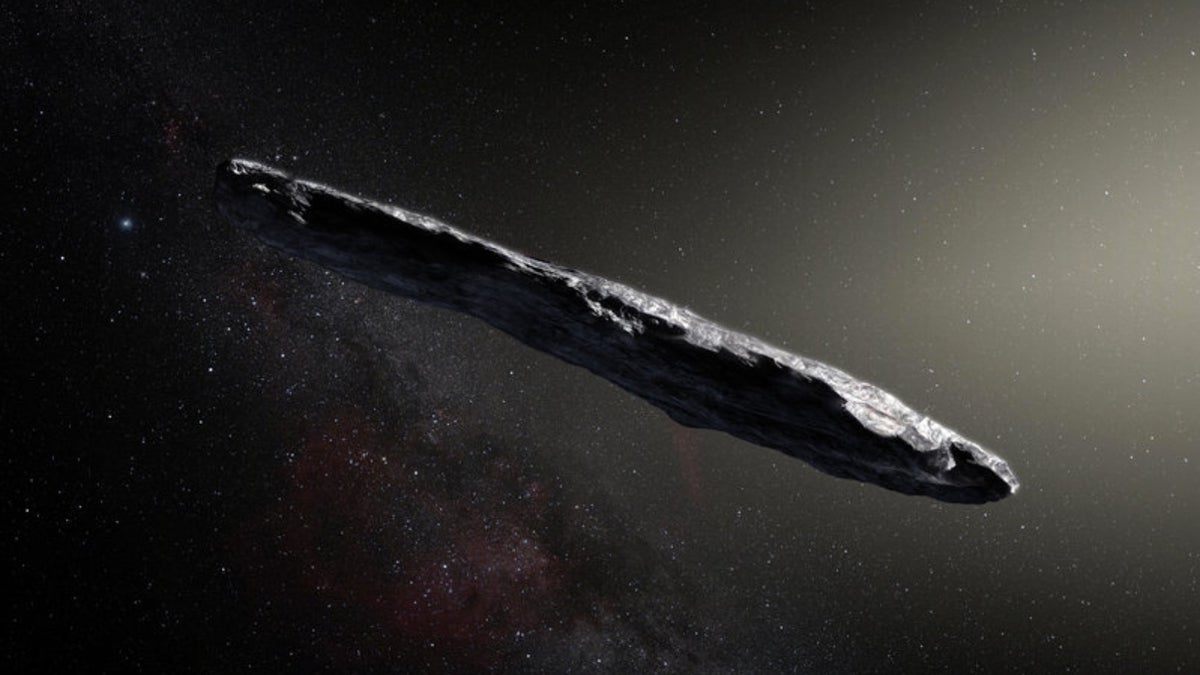
An artist's depiction of Oumuamua, the first detected interstellar object. (M. Kornmesser/ESO)
If you're wondering where E.T. is, he might be riding on a comet across the galaxy, according to a new study.
The study, published in The Astronomical Journal, details the implications of comet-like objects that could be "ferrying" microbial life across thousands of light years, adding that these microbes might be able to withstand the exceptionally long journey.
"The interstellar comets captured by the 'fishing net' of the solar system can be potentially distinguished by their differing orbital trajectories and ratios of oxygen isotopes through high-resolution spectroscopy of water vapor in their tails," the study's abstract reads.
INTERSTELLAR VISITOR 'OUMUAMUA' SHOULD HAVE NEVER LEFT HOME, THEORIES SAY
The discovery of the interstellar-asteroid "Oumuamua" last year, with its strange, cigar-like shape, has excited researchers that there may be more of these types of interstellar asteroids out there, with some potentially carrying life.
"The likelihood of Galactic panspermia is strongly dependent upon the survival lifetime of the putative organisms as well as the velocity of the transporter," the researchers wrote in a pre-print of the research.
They added: "Velocities between 10−100 km s−1 result in the highest probabilities. However, given large enough survival lifetimes, even hypervelocity objects traveling at over 1000 km s−1 have a significant chance of capture, thereby increasing the likelihood of panspermia."
Panspermia is the hypothesis that life on Earth originated from microorganisms in outer space that were carried here unintentionally by objects such as space dust, meteoroids and asteroids, according to an article on NASA's website.
According to Science Mag, we might be able to capture an object like Oumuamua every 100 years.
MYSTERIOUS INTERSTELLAR OBJECT IS SPINNING OUT OF CONTROL
Several theories initially popped up about Oumuamua, which is Hawaiian for “messenger from afar arriving first.” Some theorized that it could be carrying alien life or was even an alien spaceship or probe, used to explore our solar system, but NASA put that to bed, when it said it was metallic or rocky object, approximately 400 meters (1,312 feet) in length and 40 meters (131 feet) wide and had a "comet-like density and a dark red surface.
The object, which was first spotted in October 2017, zoomed past our Sun at approximately 196,000 mph. It was eventually classified as a comet in June, after researchers wrote the "physical properties of its surface resemble those of cometary nuclei, even though it showed no evidence of cometary activity."
The study's lead author, Idan Ginsburg, from the Harvard-Smithsonian Center for Astrophysics, believes that if other interstellar objects were moving as fast as Oumuamua, the Milky Way galaxy could capture roughly 10 million of them over the span of 1 million years.
If you look at the galaxy as a whole, you expect this to happen fairly often,” Ginsburg said, according to Science Mag.
INTERSTELLAR VISITOR 'OUMUAMUA' IS A COMET AFTER ALL
Princeton University astronomer Ed Turner believes Ginsburg and his team may be reading too much into Oumuamua, given that this the first time an interstellar object has appeared in our galaxy. “There’s no rigorous mathematical argument you can write about one event evaluated a posteriori,” he said.
Still, Ginsburg and the researchers aren't giving up hope, according to comments obtained by the Daily Mail.
"Considering the vast number of objects which are expected to be captured finding signs of extraterrestrial technology will be difficult, although a worthwhile search," the researchers said.
Follow Chris Ciaccia on Twitter @Chris_Ciaccia




















